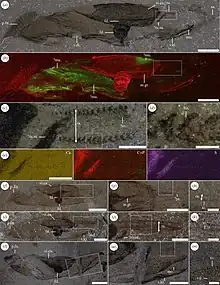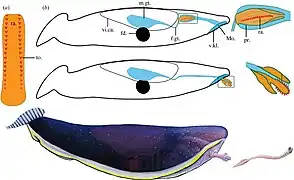Typhloesus
Typhloesus wellsi is an extinct species of enigmatic bilaterian animals from the Bear Gulch Limestone. It was once thought to be the first body fossil of a conodont, based on what turned out to be its gut contents; it is now thought to exhibit a radula, which would make it a mollusc,[1] although different types of animal have independently evolved radula-like features. Mark Purnell, of the Centre for Palaeobiology at the University of Leicester, said that it was not definitively known "what this weird thing is".[2]
| Typhloesus Temporal range: | |
|---|---|
 | |
| Fossil specimens | |
| Scientific classification | |
| Domain: | Eukaryota |
| Kingdom: | Animalia |
| Superphylum: | Lophotrochozoa |
| Phylum: | Mollusca (?) |
| Genus: | †Typhloesus (Conway Morris, 1990) |
| Species: | †T. wellsi |
| Binomial name | |
| †Typhloesus wellsi (Melton and Scott, 1973) | |
Discovery
Typhloesus was first described back in 1973 from Carboniferous rocks in Montana.[3] The animal was then jokingly referred to as the ‘alien goldfish’ by subsequent studies.[1] Because of its highly enigmatic nature, this organism was only mentioned briefly in several papers.[1] It was then thought to have been the first known body fossil of a conodont, which are a primitive group of jawless agnathan fish distantly related to lampreys and hagfish.[4] This was based on the presence of "conodont elements", which are the small comb-like teeth of those animals. The teeth however were actually located in the gut contents of the Typhloesus, meaning that while it wasn't a conodont, they were a part of its diet.[1] The animals taxonomy would be shrouded in mystery for over 30 years until in September 2022, when a new paper published revealed several potential mollusk-like features of the animal.[1]
Description

It has a fusiform (spindle-shaped) body, with a maximum length of 90 mm. At the posterior or backside of the animal is a caudal fin, which was supported by two sets of orthogonal fin rays. The exterior lacks any other organs. The internal anatomy consists of a foregut and a midgut. The gut lacks a midsection and an anus. Beneath the midgut is a disc shaped organ, tentatively called a ferrodiscus; the purpose of this organ is unknown, however it has a high concentration of iron.[3]
Paleoecology
It might have been both a predator and a scavenger, as its fossils sometimes contains conodont teeth and worm teeth located in the midgut of the animal.[1]
See also
References
- Conway Morris, Simon; Caron, Jean-Bernard (2022). "A possible home for a bizarre Carboniferous animal: Is Typhloesus a pelagic gastropod?". Biology Letters. 18 (9). doi:10.1098/rsbl.2022.0179.
- Davis, Nicola (21 September 2022). "'Alien goldfish' may have been unique mollusc, say scientists". The Guardian.
- Conway Morris, Simon (1990-04-12). "Typhloesus wellsi (Melton and Scott, 1973), a bizarre metazoan from the Carboniferous of Montana, U. S. A". Philosophical Transactions of the Royal Society of London. B, Biological Sciences. 327 (1242): 595–624. Bibcode:1990RSPTB.327..595M. doi:10.1098/rstb.1990.0102.
- Miyashita, Tetsuto; Coates, Michael I.; Farrar, Robert; Larson, Peter; Manning, Phillip L.; Wogelius, Roy A.; Edwards, Nicholas P.; Anné, Jennifer; Bergmann, Uwe; Palmer, A. Richard; Currie, Philip J. (2019-02-05). "Hagfish from the Cretaceous Tethys Sea and a reconciliation of the morphological–molecular conflict in early vertebrate phylogeny". Proceedings of the National Academy of Sciences. 116 (6): 2146–2151. Bibcode:2019PNAS..116.2146M. doi:10.1073/pnas.1814794116. ISSN 0027-8424. PMC 6369785. PMID 30670644.